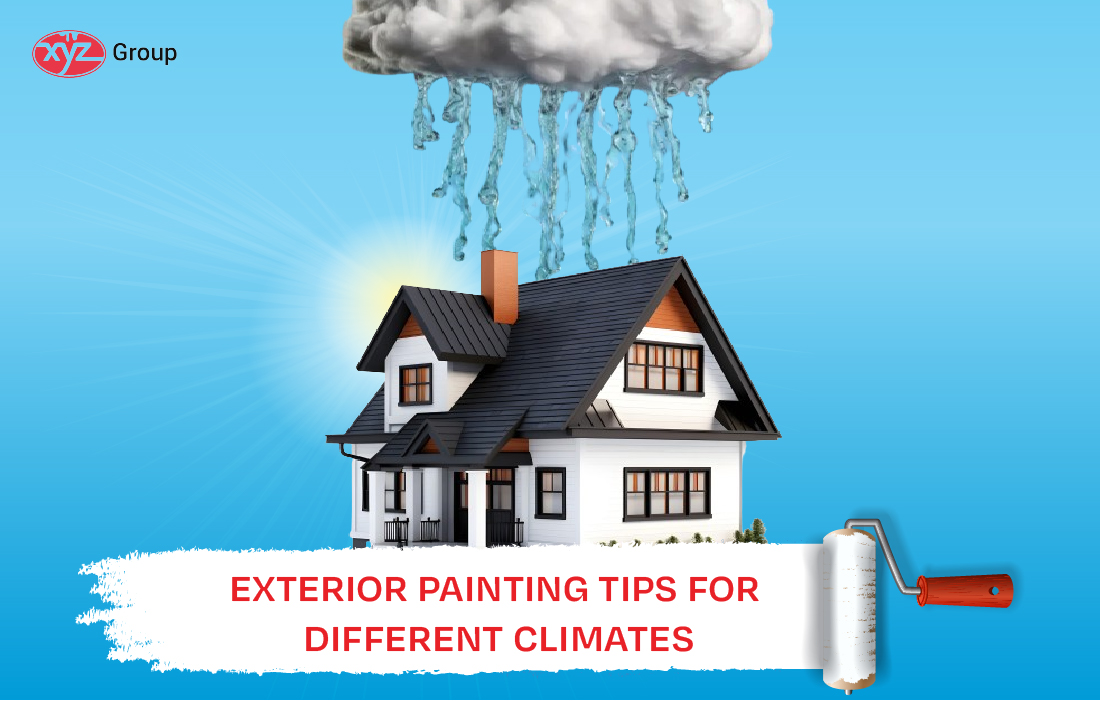Exterior Painting Tips for Different Climates
Tue, Feb 20, 2024
Read in 5 minutes

Dreaming of a fresh, vibrant exterior paint job for your home? Hold on, paint warriors! Before you grab the brush, consider this: climate plays a starring role in the success of your project. Don’t worry, though! We’ve got your back with expert tips for tackling any climate, ensuring your paint job becomes a masterpiece, not a mess.
Exterior home painting is an essential part of maintaining the beauty and integrity of your home. However, when it comes to painting the exterior of your home, it’s crucial to consider the climate you live in. Different climates can present unique challenges that may affect the longevity and durability of your paint job. Home painting jobs might seem all fun and dandy but you need to take great care to make it both pleasing and durable.
Conquering the Cold
Winter wonderland might be beautiful, but it’s not exactly paint-friendly. Wait until temperatures consistently stay above 50°F (10°C) to avoid uneven application and peeling. Opt for latex paints specifically formulated for cold weather, and avoid painting in direct sunlight or high winds. Remember, icy surfaces are a no-go – wait for a thaw before picking up the brush. If you are planning to start your painting job in winter, it is not a wise decision at all. The cold will do more harm than good.
To ensure successful painting in cold climates, avoid painting when temperatures are near or below freezing and choose paint products that can withstand extreme temperatures. Additionally, consider using a paint additive to prevent freezing and promote proper curing in cold weather conditions.
Some paint companies make special kinds of paint that can handle the cold better. These paints are designed to stay flexible even when it’s freezing outside, so they won’t crack or peel like regular paint might. Once you start painting, try to work quickly and efficiently. You don’t want the paint to freeze before it has a chance to dry properly. And if you’re using a roller or brush, make sure you’re not pressing too hard, or you might end up with streaks or uneven coverage.
Braving the Heat
Hot summer days might be perfect for swimming, but painting? Not so much. Avoid midday heat, aiming for early mornings or evenings when temperatures are cooler. Opt for heat-resistant paints that reflect sunlight, preventing fading and blistering. And remember, proper hydration is key for both you and your paint job!
In hot climates, the intense sun and high temperatures can cause paint to dry too quickly, leading to poor adhesion and an uneven finish. To combat this issue, consider painting early in the morning or late in the afternoon when temperatures are cooler. Additionally, avoid exterior home painting in direct sunlight and choose light-colored paint shades that reflect heat rather than absorbing it. If you feel like it will be too much work you can always get paint companies to send professionals to take up the hard work.
Make sure your surfaces are clean and dry. You don’t want any dirt or dust getting mixed up in your paint job! And if it’s really hot outside, consider giving your surfaces a quick rinse with water to cool them down before you start painting.
Navigating the Damp
In humid climates, moisture can be a significant concern for exterior painting projects. To prevent moisture-related issues such as peeling, blistering, and mold growth, choose paint products that are specifically formulated for humid conditions. Additionally, ensure proper ventilation during the painting process to allow moisture to escape and promote drying.
Living in a damp climate? Moisture is your paint’s enemy. Ensure surfaces are completely dry before painting, and wait for several dry days with low humidity for optimal results. Choose mildew-resistant paints and avoid painting during rainy periods. Remember, proper ventilation is crucial for drying and preventing mold growth.
When you’re painting in damp weather, you gotta work a bit differently. The moisture in the air can make the paint take longer to dry, so you’ll need to be patient. Try to cover small areas at a time and give each coat of paint plenty of time to dry before you move on to the next one.
Seasonal Painting Tips
Choosing Your Paint Champion:
Selecting the right paint is crucial while you decide your exterior home painting. Opt for high-quality exterior paints designed for your climate. Consider acrylic latex paints for versatility, or alkyd paints for superior moisture resistance. Remember, specialty paints exist for specific materials like wood or stucco. Consult your local paint store experts for tailored recommendations.
Weather Wisdom:
Mother Nature can be unpredictable. Always check the weather forecast before painting, avoiding rainy days and excessive wind. Schedule painting projects during periods of stable weather for best results. Remember, paint needs time to dry before facing harsh elements – factor in drying times when planning your project.
Regional Round-Up:
Coastal warriors: Be wary of salty air, choosing paint with anti-corrosion properties.
Mountain magic: High altitudes bring extreme temperatures – opt for flexible paints that withstand expansion and contraction.
Desert dilemmas: Harsh sun and dryness demand UV-resistant paints with high-solids content.
Conclusion
In conclusion, exterior home painting can significantly enhance the appearance and value of your home. By understanding the climate-specific challenges you may face and following the tips, you can achieve a beautiful and durable exterior paint job that stands the test of time. Whether you live in a hot and sunny climate, a cold and snowy climate, or a humid and rainy climate, proper preparation and painting techniques can ensure optimal results for your home.
Get A Free Estimate!
Recent Posts
Drywall Contractors Vancouver
Drywall Service in Richmond
Drywall Contractors Surrey
Why Build Your Home Partition with Drywall?
Make Your Home Walls Beautiful and Safe with Drywalls